
hotline:
17715390137
Tel/Wechat:
18101240246 (Technology)
0512-68565571
Email:mxenes@163.com (Sales Engineer)bkxc.bonnie@gmail.com
Scan the code to follow or search the official account on WeChat:
2D Materials Fronrier After paying attention,
click on the lower right corner to contact us,
Enter enterprise WeChat.
Professional Services Online

已传文件:photo/2020311172347346.png
Professor profile
Guihua Yu is a tenured professor in the Department of Materials Science and Engineering and the Department of Mechanical Engineering at the University of Texas at Austin. He graduated from the Department of Chemistry of the University of Science and Technology of China in 2003 with a bachelor‘s degree and the highest undergraduate award of the “Guo Moruo Scholarship”. He obtained his Ph.D. from Harvard University in 2009 and worked as a postdoctoral researcher at Stanford University from 2009 to 2012. An important research direction of Professor Yu Guihua‘s research group is the advanced flow battery design based on new energy materials and chemistry, interdisciplinary research in integrated chemical science, materials science and energy science, including the physical / chemical properties of active substances through organic synthesis. Optimization, combined with molecular-level electrochemical reaction mechanism and reaction kinetics research, supplemented by theoretical calculation simulation, has created and developed a series of new lithium-based flow batteries, organic flow batteries, eutectic solvent flow batteries, and so on. By extending the principle of "atomic economy" to the field of energy, it has opened up new methods for the development of the next generation of green energy storage materials. Currently in Science, Nature, Nature Nanotech., Nature Commun., Science Advances, PNAS, Chem. Soc. Rev., Acc. Chem. Res., Chem, Joule, JACS, Angew. Chem., Adv. Mater., Published more than 140 papers in internationally renowned scientific journals such as Nano Lett., Energy Environ. Sci., ACS Nano, Nano Today, Adv. Energy Mater., Adv. Funct. Mater. Journal), paper cited 23,000 times, H-index ~ 72. His publication work has been reported by several international media highlights, including Nature News, Science News, ABC News, Fox News, Forbes, Discover, National Geographic, Science Daily, R & D Magazine, MIT Technology Review, Popular Science, Ars Technica, C & EN , IEEE Spectrum, Chemistry World, Materials World, MRS Bulletin, etc.
Professor Yu Guihua is the Deputy Editor-in-Chief of ACS Materials Letters and the editorial board member of a series of internationally renowned chemistry and materials science and technology journals: Chemical Society Reviews, Chem, ACS Central Science, Chemistry of Materials, Scientific Reports, Energy Storage Materials, Science China Chemistry, Science China Materials, PLOS One, Batteries & Supercaps, Energy & Environmental Materials, Frontiers in Energy Research, Energies, etc. He has won several important international academic awards, including the Fellow of the Royal Society of Chemistry (FRSC), the U.S. Department of Energy Distinguished Young Scientist Award, the famous Camille Dreyfus Teacher-Scholar Award and the Sloan Research Fellow, Nano Letters, Chemical Society Reviews, Small, etc. Outstanding Young Scientist Award, Royal British Chemical Society and American Chemical Society "Outstanding Young Chemist" Award, 35 outstanding young innovative people worldwide selected by the Massachusetts Institute of Technology (MIT) One of them is one of the five international young chemist awards issued by the International Union of Pure and Applied Chemistry (IUPAC).
This article briefly summarizes the pioneering work and latest progress of Professor Yu Guihua‘s group in the field of flow batteries.
(I) Design of new lithium-based flow battery based on combined electrolyte
1.A Chemistry and Material Perspective on Lithium Redox Flow Batteries Towards High-density Electrical Energy Storage, Chemical Society Reviews, 44, 7968 (2015), DOI: 10.1039 / C5CS00289C.
For the first time, the concept, structural characteristics and system advantages of lithium-based flow batteries were systematically summarized and explained. By combining the characteristics of traditional flow batteries and lithium-ion batteries, lithium-based flow batteries are expected to achieve high scalability and high energy density at the same time. In addition, the main challenges and future research directions of this new type of flow battery are also discussed in depth.

2.Reversible Br2 / Br−Redox Couple in Aqueous Phase as High-performance Catholyte for Alkali-Ion Batteries, Energy & Environ. Science, 7, 1990 (2014), DOI: 10.1039 / C4EE00407H.
Through the design of the combined electrolyte, this article first realized a lithium-based flow battery with a discharge voltage of up to 3.9 volts. The active material based on the bromine positive electrode and lithium metal negative electrode got rid of the environmental and resource restrictions of traditional transition metal materials and realized A capacity of 290 mAh per gram and a power density of 1000 watts per kilogram.
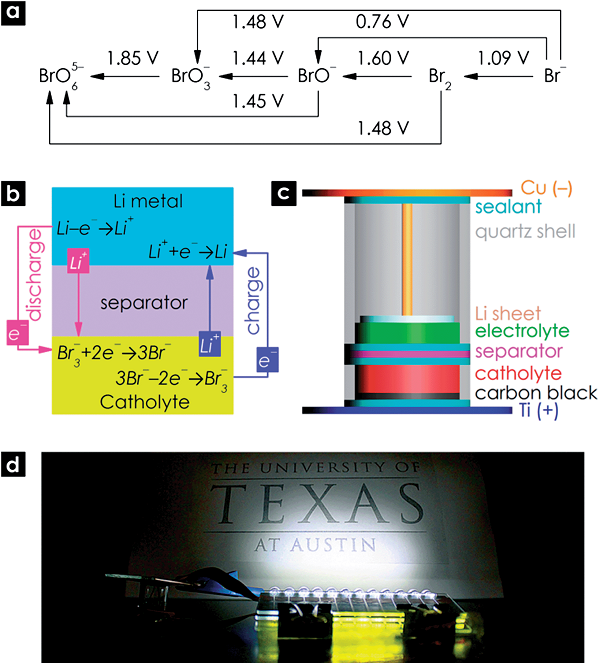
3.Sustainable Electrical Energy Storage through the Ferrocene / Ferrocenium Redox Reaction in Aprotic Electrolyte, Angew. Chem. Int. Ed., 53, 11036 (2014), DOI: 10.1002 / anie.201406135.
For the first time, a sandwich compound represented by ferrocene was used as an active material to pair with a lithium metal anode. This paper first realized a new organic flow battery based on metal organic chemistry. Due to its stable molecular structure and the mechanism of the outer layer electron transfer process, the metal The metallocene complex has a reaction kinetic constant that is several orders of magnitude higher than that of traditional active materials, and the solubility can reach 1.5 M in ordinary ether electrolytes. Battery performance tests have shown that the battery can output a capacity of 130 milliamp hours and 3.5 volts. High voltage, and has stable cycling and almost 100% Coulomb efficiency.
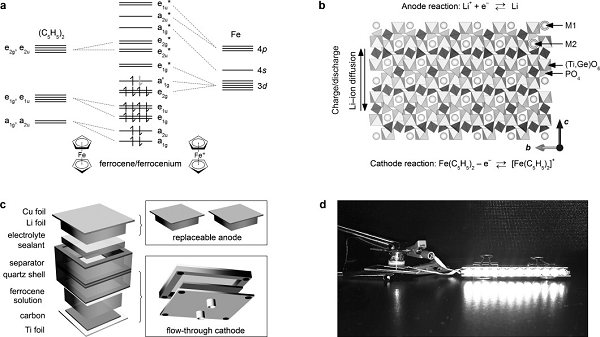
4.A Membrane-Free Ferrocene-Based High-Rate Semiliquid Battery, Nano Letters, 15, 4108 (2015), DOI: 10.1021 / acs.nanolett.5b01224.
Utilizing the ultra-high electrochemical kinetics of the active material and the rational design of the solid electrolyte interface film of the metal lithium negative electrode, this paper first realizes a separator-free lithium-based flow battery based on a metal-organic sandwich compound. The formation of a dense passivation film in situ on the surface of the lithium metal negative electrode by chemical methods can effectively inhibit battery self-discharge. The active positive electrode liquid based on ferrocene molecules can achieve a stable cycle of up to 500 cycles and shows excellent Power performance.

(II) Design of Flow Battery Based on Organic Active Small Molecules
1.Molecular Engineering of Organic Electroactive Materials for Redox Flow Batteries, Chemical Society Reviews, 47, 69 (2018), DOI: 10.1039 / C7CS00569E.
Professor Yu Guihua‘s team was invited to publish a special review paper on organic flow batteries online in the international authoritative review journal Chemical Society Review, which systematically summarized the molecular engineering methods for the regulation of the properties of electrochemically active materials, including solubility, redox potential, Molecular scale and stability, etc. Through functionally-oriented organic chemical synthesis, on the one hand, the solubility of organic active molecules can be regulated by the polar difference between the substituent and the solvent; on the other hand, the redox potential of the organic pair is affected by the substituent-induced effect, It can be further quantified by Hammett‘s equation; in addition, this review also summarizes the characterization and prediction of the stability of organic molecules by comprehensive electrochemical analysis and theoretical simulation calculation methods, and systematically introduces a series of carbonyl, radical, polymer and Molecular regulation and performance optimization of active materials for flow batteries with metal complexes. The article finally discusses the current challenges of organic flow battery technology and looks forward to the development prospects in this field.

2.A Bio-Inspired, Heavy-Metal-Free, Dual-Electrolyte Liquid Battery towards Sustainable Energy Storage, Angew. Chem. Int. Ed., 55, 4772 (2016), DOI: 10.1002 / anie.201600705.
This paper first uses the smallest quinone molecule, hydroquinone, as a water-soluble active material, paired with lithiated graphite as a negative electrode material, to achieve a new type of hybrid flow battery; achieving a high voltage of 3.4 volts and Specific capacity of 395 mAh per gram.
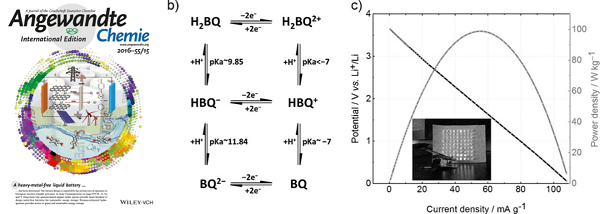
3.Exploring Bio-Inspired Organic Redox Flow Batteries, Chem, 1, 790 (2016), DOI: 10.1016 / j.chempr. 2016.09.004.
This article systematically reveals for the first time the effects of different molecular structures on the electronic structure and electrochemical performance of quinone-active small molecules. Detailed performance tests and theoretical calculations indicate that the reversibility of the reaction of quinone molecules is affected by the overall aromaticity of the fused ring compound. By grafting the aromatic group to the active group, the delocalized π bond can be effectively expanded, and the Stability, and finally achieved almost 100% capacity retention for 100 laps. The purpose of this article is to provide a theoretical and experimental combination of design ideas for future small-cell-based flow batteries.

4.A High-Performance All-Metallocene-Based, Non-Aqueous Redox Flow Battery, Energy & Environ. Science, 10, 491 (2017), DOI: 10.1039 / C6EE02057G.
By systematically studying the electronic structure and electrochemical characteristics of a series of metallocene complexes, and through rational solvent screening and molecular screening, ferrocene was used as the positive electrode material and cobalt ferrocene as the negative electrode material. Novel non-aqueous flow battery with metallocene complex. After systematic molecular engineering and structural optimization, the working voltage of the new non-aqueous flow battery based on metallocene complexes can be stabilized at 2.1 V, and it also has a stable charge-discharge curve and battery polarization curve at large concentrations. With stable performance and huge potential, it provides new ideas for the molecular structure design of the next-generation sustainable green flow battery.
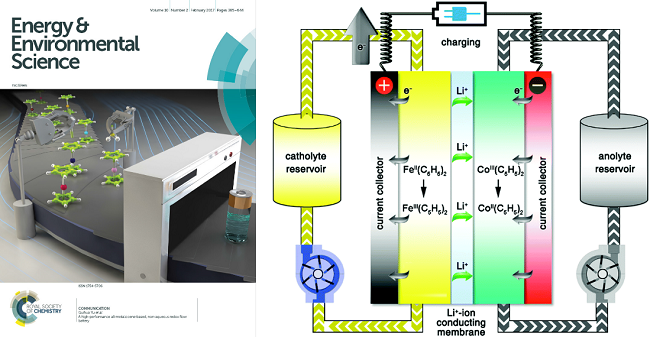
5.Phenothiazine-based organic catholyte for high-capacity and long-life aqueous redox flow batteries, Advanced Materials, 1901052 (2019), DOI: 10.1002 / adma.201901052.
Recently, small organic molecules can be used in molecular engineering to achieve performance and solubility control, which has made a great deal of progress in the design of water-based flow batteries. Here, this paper uses a methylene blue dye molecule to achieve long-term stable cycling in acidic solution, super power density, close to 100% Coulomb efficiency, and high capacity of 71 amps per liter.
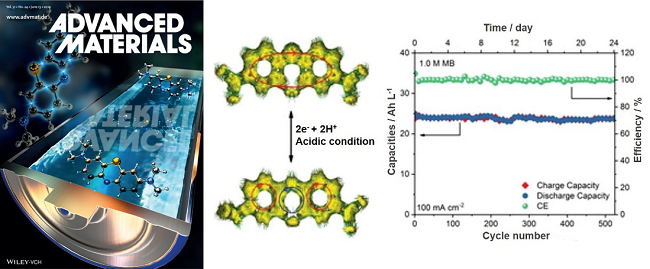
(3) Design of high energy density flow battery based on the concept of eutectic solvent
1.Eutectic Electrolytes for High-Energy-Density Redox Flow Batteries, ACS Energy Letters, 3, 2875 (2018), DOI: 10.1021 / acsenergylett.8b01899.
For the first time, this article systematically outlines the wide application of the design of electrolytes based on eutectic solvents in the field of energy storage, especially in the direction of flow batteries. At the same time, it discusses its special physical and chemical properties, high concentration advantages and related coordination chemistry . Finally, the future challenges and opportunities in flow battery design are discussed in depth.

2.A Sustainable Redox-Flow Battery with an Al-based Deep-Eutectic-Solvent Anolyte, Angew. Chem. Int. Ed., 56, 7454 (2017), DOI: 10.1002 / anie.201703399.
In this paper, the aluminum-based eutectic solvent was prepared for the first time using anhydrous aluminum chloride and urea at room temperature, so that the aluminum metal negative electrode could be charged and discharged. By matching with halogen-based active materials, a hybrid battery with high energy density was designed.
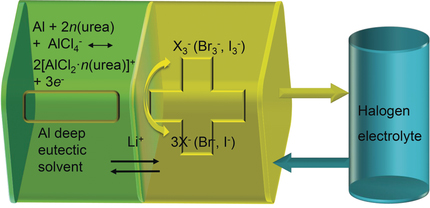
3.A Low-Cost High-Energy Hybrid Fe-Al Liquid Battery Achieved by Deep Eutectic Solvents, Joule, 1, 623 (2017), DOI: 10.1016 / j.joule.2017.08.013.
In this paper, based on the concept of eutectic solvent, a hybrid flow battery based on an aluminum metal negative electrode and an iron-based redox positive electrode was realized for the first time. By simply mixing hydrated ferric chloride and urea in the air, a large amount of iron-based eutectic solvent can be prepared quickly; in addition, by adding specific functional assistants, it is possible to control the iron ion coordination environment and thereby regulate its electrochemistry The purpose of the reaction.
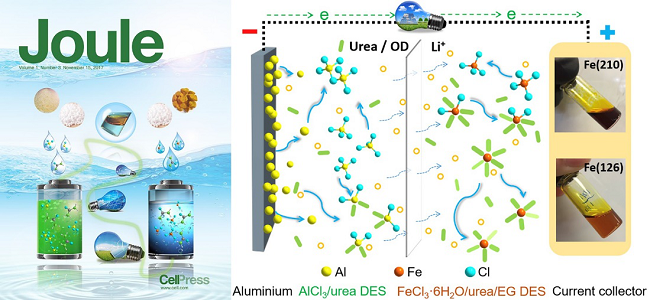
4.Highly Concentrated Phthalimide-based Anolytes for Organic Redox Flow Battery with Enhanced Reversibility, Chem, 4, 2814 (2018), DOI: 10.1016 / j.chempr. 2018.08.024.
In this paper, for the first time, a negative active electrolyte based on a eutectic solvent was designed using phthalimide as an active small molecule, urea and lithium salts. By adjusting the molar ratio between the three, the physical and chemical properties of the three can be adjusted, thereby achieving a high energy density flow battery.
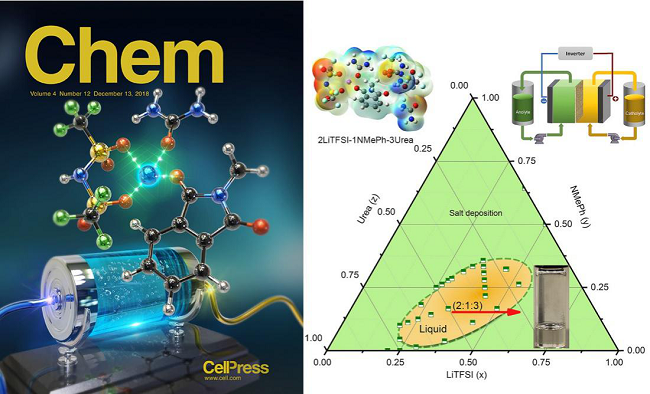
5.Insights into Hydrotropic Solubilization for Hybrid Ion Redox Flow Batteries, ACS Energy Letters, 3, 2641 (2018), DOI: 10.1021 / acsenergylett.8b01828.
In this paper, the solubility of a variety of active small molecules in water can be greatly improved by using solubilizing molecules with hydrophilic groups such as urea. Taking the hydroquinone molecule as an example, by adding urea as a co-solvent, the solubility in water was increased by three times. By matching with different metal negative electrodes, a series of new hybrid flow battery designs can be realized.
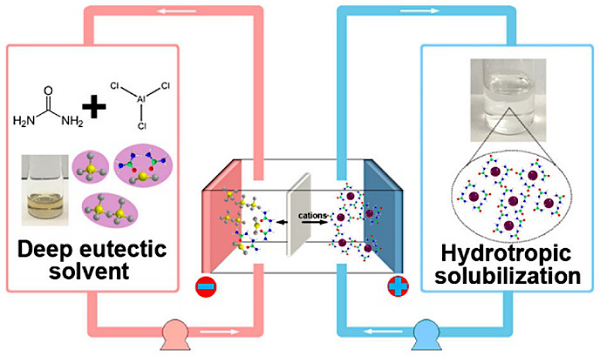
6.Biredox eutectic electrolytes derived from organic redox-active molecules for high-energy storage systems, Angew. Chem. Int. Ed., 58, 7045 (2019), DOI: 10.1002 / anie.201902433.
In this paper, for the first time, a design of a eutectic solvent based on two organic active molecules was realized. By mixing butylphthalimide and dimethylferrocene at room temperature, the thus prepared high-concentration active electrolyte can be used as both a positive electrode and a negative electrode, thereby reducing possible cross-contamination when a porous separator is used.
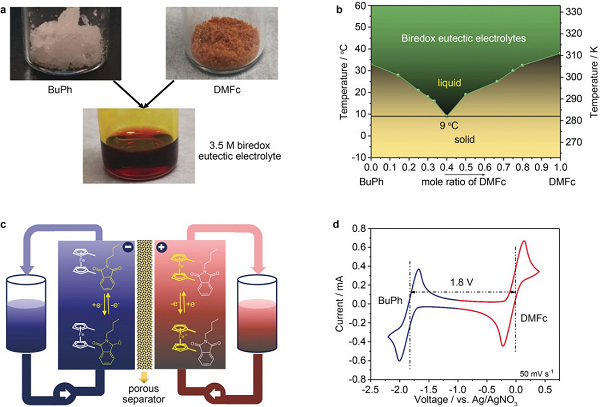
(IV) Future research trends based on new flow battery designs
1. Pathways to Widespread Applications: Development of Redox Flow Batteries Based on New Chemistries, Chem (2019), In press, DOI: 10.1016 / j.chempr.2019.05.010.
This article systematically describes the current development trend of flow batteries based on new chemical designs, including the design of high-concentration active materials, the application of alkali metal anodes, and the concept of photocharging. By analyzing the structure of different new-type flow batteries, the requirements for the physicochemical properties of the active materials are put forward, and the possible problems and challenges are discussed.
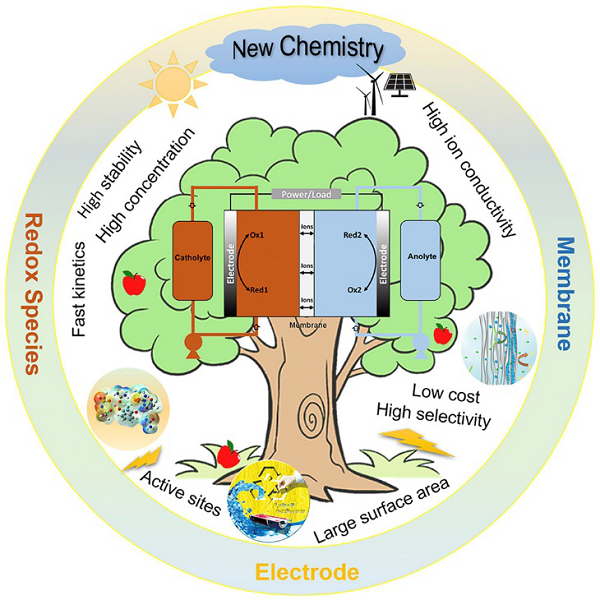
2. Progress and Prospects of Next Generation Redox Flow Batteries, Energy Storage Materials, 15, 324 (2018), DOI: 10.1016 / j.ensm.2018.06.008.
This article systematically summarizes the latest progress and future development trends of flow battery research. On the basis of summarizing the progress of various aspects of flow batteries, this article preliminary puts forward the current urgent problems and several potential development directions of flow batteries.
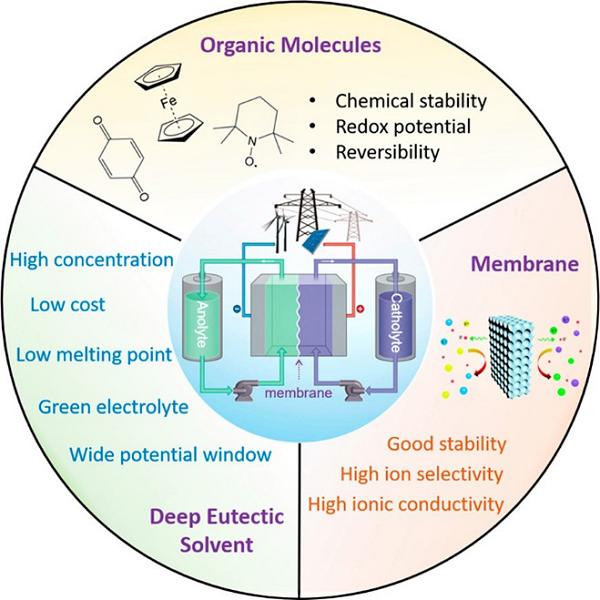
3.Enabling Graphene-Oxide-Based Membranes for Large-Scale Energy Storage by Controling Hydrophilic Microstructure, Chem, 4, 1035 (2018), DOI: 10.1016 / j.chempr. 2018.02.003.
In this paper, by controlling the oxygen-containing functional groups on the surface layer of graphene oxide sheet, the application of graphene oxide film in water-based flow battery was realized for the first time. Through the repeated stacking of graphene sheets, the three-dimensionally connected two-dimensional channels can not only achieve the rapid conduction of multiple monovalent ions, but also effectively block the active small molecules.
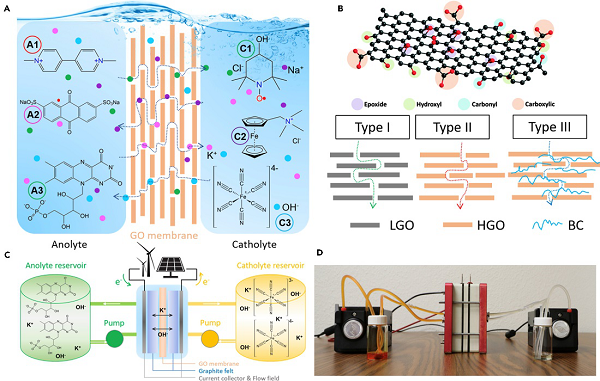
4.Gradient-Distributed Metal-Organic Framework-Based Porous Membranes for Nonaqueous Redox Flow Batteries, Advanced Energy Materials, 8, 1802533 (2018), DOI: 10.1002 / aenm.201802533.
In this paper, for the first time, a composite membrane design based on MOF particles and a porous commercial membrane was realized. Through the gradient distribution of the MOF particle layer in the vertical direction of the porous membrane, the effective blocking of the active material is achieved without damaging the high ionic conductivity of the porous membrane. By applying it to the ferrocene organic system, the design concept of this composite structure diaphragm is fully proved.
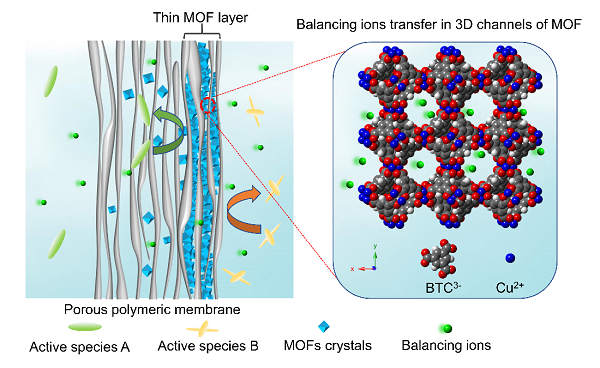
5.Efficient Solar Energy Harvesting and Storage through a Robust Photocatalyst Driving Fast Redox Reactions, Advanced Materials, 30, 1802294 (2018), DOI: 10.1002 / adma.201802294.
In this paper, a single-electrode photorechargeable flow battery based on a high-efficiency photoanode is designed for the first time. By using WO3 doped BiVO4 as a photo-charging anode, the light conversion efficiency of this flow battery can reach 1.25%, while maintaining a stable efficiency output during a cycle of up to 20 turns. The photo-charged flow battery realizes the integrated design of energy conversion and storage, and provides a new way for the extensive use of sustainable energy.

Source of information: material cattle

| Reminder: Beijing Beike New Material Technology Co., Ltd. supplies products only for scientific research, not for humans |
| All rights reserved © 2019 beijing beike new material Technology Co., Ltd 京ICP备16054715-2号 |